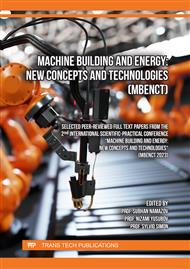p.3
p.13
p.21
p.27
p.33
p.41
p.47
p.59
Sorbents Based on Iron Oxide Nanoparticles for Release of Tetracyclines for Water Treatment
Abstract:
The aim of the research was to establish and produce unfamiliar magnetic absorbents based on a commonly accessible specimen containing crown ethers via iron nanoparticles (magnetite), investigation their structural, magnetic, and absorbance properties, and analyze the possible utilization of these sorbents for the sorption and accumulation of tetracyclines. New crown complexes with biological prop ethers have been created, and the structure of the produced crown complexes has been determined using elemental analysis data from studies of these samples' IR, mass, and NMR spectra. According to the contact duration between the phases, the pH and solution's composition, the structure of tetracyclines, and their concentration, an organized research of the sorption of tetracycline on a magnetic composite with crown ethers was conducted as a component of the study. Crown ethers and Fe3O4 (CE@Fe3O4NPs) nanoparticles were produced under certain conditions, and the composites' magnetic and structural characteristics were evaluated. Tetracyclines were evaluated for their ability to bind to the nanostructures produced by CE@Fe3O4 NPs. These structures have no negative effects and remain safe for consumption. Crown ethers are currently produced using novel techniques, and new magnetic sorbents made with crown ethers and Fe3O4 nanoparticles have also been developed. It has been shown that magnetic sorbents composed of Fe3O4 nanoparticles and crown ethers have superparamagnetic characteristics. The research in consideration identifies and discusses the characteristics of tetracyclines' sorption behavior. There are several methods for concentrating tetracyclines for sorption onto a magnetic sorbent using Fe3O4 nanoparticles and crown ethers from aqueous solutions. Our research has demonstrated, using the example of produced CE@Fe3O4 NPs nanostructures, that mixing the nanotechnological approach with the methods of supramolecular chemistry offers a large adsorption effectiveness.
Info:
Periodical:
Pages:
13-19
Citation:
Online since:
April 2024
Authors:
Keywords:
Price:
Сopyright:
© 2024 Trans Tech Publications Ltd. All Rights Reserved
Share:
Citation:




